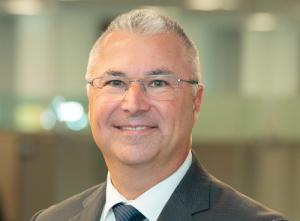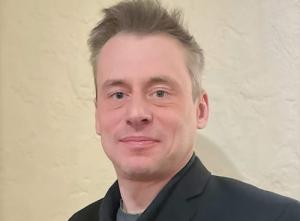Eversource, EY
Ron Utterbeck is the CIO of Eversource. Boris Zamolodchikov is Managing Director at EY.
One of the great principles among energy and utilities companies is the sharing of information so all can thrive. There is an opportunity for other utilities to learn from an award-winning project on the digital transformation at a publicly traded Fortune 500 company based in the New England region.

Eversource Energy completed a digital transformation, working with EY, to upscale its systems and support future customer-focused innovations. The utility's digital transformation journey, powered by EY's Agile SAP approach, earned them the Large Enterprise Utility of the Year award at the #SAP4U conference.
The process and how it was effective is discussed here so all may learn from the journey. Public Utilities Fortnightly digs into how so much was accomplished with Eversource CIO Ron Utterbeck and EY Managing Director Boris Zamolodchikov.
PUF's Steve Mitnick: Ron, talk about the digital transformation at Eversource, which won the award. What were your goals? What did you envision as success?
 Ron Utterbeck: Implementing a modern CIS allows us to realize more benefits from AMI. One example is time-varying rates. Our legacy system couldn’t have handled that.
Ron Utterbeck: Implementing a modern CIS allows us to realize more benefits from AMI. One example is time-varying rates. Our legacy system couldn’t have handled that.
Ron Utterbeck: I've been at Eversource for three years and when I got here, the team had started on a journey to implement SAP from a customer information system standpoint. We purchased the Columbia Gas system, and as part of that, had to incorporate those three hundred thousand Columbia Gas customers into our Eversource system.
The decision was made not to bring them on our twenty-plus-year-old legacy Customer Information System (CIS). Instead, we chose to implement a state-of-the-art SAP CIS, providing a platform going forward to support our customers in a more efficient manner.
Phase one was bringing the Columbia Gas customers on as quickly as possible. Phase two was doing this for the remaining two million Massachusetts customers, and a driving force was we were rolling out Advanced Metering Infrastructure (AMI) in Massachusetts, as well.
Implementing a modern CIS allows us to realize more benefits from AMI. One example is time-varying rates. Our legacy system couldn't have handled that. As we put capabilities in our meter, we needed to move to a modern CIS.
 Boris Zamolodchikov: It’s important to have flexibility. The Agile process is not a rigorous process, it’s a set of recommendations. It requires taking the team’s feedback on how to improve the process. The teams on the ground know better than anyone else what they need to improve.
Boris Zamolodchikov: It’s important to have flexibility. The Agile process is not a rigorous process, it’s a set of recommendations. It requires taking the team’s feedback on how to improve the process. The teams on the ground know better than anyone else what they need to improve.
We started using a Waterfall methodology and then moved to Agile. When we kicked off phase two, we decided to only follow an Agile approach.
Our CIS officially went live in February for a small number of our western Massachusetts customers and then the rest of the state by the end of May. All Eversource electric and gas customers in Massachusetts are now using the same CIS for the first time in our history. I want to thank the team for rolling out this system flawlessly.
Ultimately, success is implementing this complex customer-facing system, on time, on budget, with high quality billing. We did all that and more and a core tenet of our success was using an Agile implementation approach.
PUF: What do you mean by Waterfall?
Ron Utterbeck: Waterfall is a legacy development methodology for transformations like this one. While it's still valid, it typically is step-by-step oriented �" first focused on defining exactly what we want. Next, is a requirement phase, then a build phase, a test phase, and then training and deployment.
With an Agile methodology, you are building while defining exactly what is wanted. Another element of Agile is to separate the program into multiple increments, so for example, we used twelve-week development increments. This approach allowed us to get the benefits faster and pivot along the way.
PUF: Boris, you're with EY. Where did you come in?
Boris Zamolodchikov: We started talking immediately following phase one, because Ron made it clear it was important to implement this Agile approach and provide flexibility within the team. To do it in the context of such a large program was exciting and required an all hands-on-deck approach.
Early on, our goal was to create the solution in an iterative fashion and allow for the business to continually view that solution as it evolved, as it progressed.
Throughout the program, we saw ourselves as one team: this meant starting by getting everybody trained in Agile, excited about the approach at the beginning, and working collaboratively throughout each of the increments.
PUF: Ron, talk about how this SAP implementation was different. What were the keys to success?
Ron Utterbeck: Our number one priority was the continuity of our billing experience for existing customers. At its core, the SAP system that was implemented is our meter-to-cash system that enables billing and receiving payments. No matter the transformation, we needed to be able to bill reliably and accurately, just like we could for twenty-plus years in the older system.
We also focused on creating more capability and nimbleness for the organization. I'll give you an example. When you have legacy systems, any changes, especially over time, end up being costly and can be time consuming, as it's all custom coded. With our new SAP system, updates are much more configurable compared to our previous hard-coded options.
As a result, we are now nimbler. If there is a new regulation, the changes to our system can be implemented significantly faster, and at a lower cost. When our business or customer needs evolve, we're able to keep up with those changes, again, faster and at a lower price point.
PUF: When you say lower cost, what does that mean to the Eversource customer?
Ron Utterbeck: To the Eversource customer, it continues to mean we are managing our dollars as effectively as possible and making sure that what customers are charged is as low and efficient as possible, while still providing safe and reliable service.
PUF: Boris, talk about feedback, and how it is used in an Agile implementation.
Boris Zamolodchikov: In an Agile methodology, feedback is critical and happens as part of the ongoing demonstration of the solution to the business, which represented Eversource's customer base.
Throughout the program, business stakeholders were hands-on and involved for a multitude of reasons. First, if the solution is not heading in the right direction, it's easier to course correct early in the program.
In addition, involving business stakeholders in the solution development program familiarizes them with the solution, so they're able to provide feedback, and envision the end state of what they want out of the system. By becoming more in tune with the technology, they can better shape the vision for that solution.
Finally, feedback through the program allows us to assess how the team is performing as we are in development. We are continuously asking key questions: Are we getting better? Are we delivering functionality faster?
If not, we go to retrospectives. We have conversations about what was done well, and what could be done better to improve our process.
In the Agile methodology, we conducted these feedback retrospectives at the end of every two-week sprint in a broader, combined team fashion, as well as at the end of every program increment. So, essentially every three months of the program.
This timeline and process for continuous feedback allowed our team to mature, grow, and perform better. We delivered significantly more features in our last product increment than in the first, which was a testament to the amount of maturity and capability the team gained in the process.
PUF: It's called a digital transformation, but it's a workforce transformation, as well.
Ron Utterbeck: It starts from the senior leaders. To drive this effectively, I needed to make sure our senior leaders knew we were going to monitor success along the way differently. We were moving from one methodology to a completely different one.
So, we couldn't measure success the same way. To enable this shift in mindset, we started with a workshop featuring hands-on experiences in Agile methodology with our senior leaders. As a result of the workshop, they were able to experience some of the key tenets and processes that we were planning on implementing.
Boris also led an exercise focused on continuous improvement in self-directed teams that allowed them to understand how feedback can improve their capabilities. This enabled our senior leaders to understand their roles in managing and leading an Agile program like this one moving forward.
The workshop also created a common language and mindset that we could build upon. The Agile methodology can be challenging for the first couple of sprints. People can start to panic after a few weeks of still not getting it.
But as a function of our workshop, we told them, "Three weeks from now it's still going to feel uncomfortable. But by the time we reach our fourth and fifth sprints, we will start to see success."
As a result of this effort and our approach from the beginning, our organization created experienced Agile leaders. Now, we can take those learnings into future projects that follow this approach.
PUF: What were the learnings?
Boris Zamolodchikov: One of the key learnings is the criticality of upfront education both at the leadership level and at a tactical level with every member of the team is instrumental. The language we all collectively learned to speak is important.
We also learned along the way that it's important to have flexibility. The Agile process is not a rigorous process, it's a set of recommendations.
As a result, it requires taking the team's feedback on how to improve the process. The teams on the ground know better than anyone else what they need to improve. It's important to have a lot of flexibility in that process, come in with an open mind that changes are going to be made, and people understand they're the ones to drive those changes.
How the teams do their work is up to them, and if it manifests in improved delivery, in more features being delivered per unit of time per sprint, then they will see that as a reward. It's important to empower the teams to make those decisions, to shape their process.
PUF: Ron, what about you?
Ron Utterbeck: For me, a key learning was the role of the senior executives on the project and how it was important to get comfortable with a flexible methodology, while maintaining a high level of involvement.
For example, myself, along with co-executive sponsors, Penni Conner and Jared Lawrence, met with the team every week to review the metrics, understand progress, assist where the team needed us, and see ultimately how the teams were learning from this methodology.
We learned throughout the project that while ultimately the teams needed to track, adjust, and improve their own performance, we also needed to monitor it closely enough to enable flexibility and agility, as well.
By checking progress in two-week sprints �" but with the overall plan as a foundation �" we were able to quickly diagnose what's happening and determine whether the teams could rectify it or if we needed to step in and move some hurdles to progress the initiative.
We'd analyze that progress in two-week sprints but also as it compared to the high-level plan of the whole project.
Ultimately, the Agile methodology helped us reach the right product faster and allowed us to understand hiccups earlier.
PUF: Are customers going to see anything different on their bills?
Ron Utterbeck: The bill is almost the same but visually improved. It's easier to pay their bills because we've consolidated account numbers. It's easier for them to see their bills as we roll out AMI and start our first meters this time next year.
Then they're going to see more capabilities coming into their hands. Again, our primary goal was continuity for our customers as we went live.
Going from a twenty-plus-year-old system to a modern system requires moving data. That typically requires taking systems offline, which would've impacted customers.
We worked hard and creatively to allow them to continue to do the majority of their business while we were cutting over and to minimize the impact on customers.
PUF: How do you envision changes like this enabling better customer connection?
Boris Zamolodchikov: Systems like these within power and utilities organizations enable more customer centricity. With additional data from areas such as AMI, more capabilities of customer information systems, and additional channels, like apps and websites and so on, customers will want to interact more with their power and utilities company.
For that interaction to become customer driven to address their concerns faster, that culture of agility needs to exist in an organization. It's imperative for utilities to build those types of capabilities now so they can be ready for this customer-centric universe.
Ron Utterbeck: The technology is cool, but what's important is we've created an organizational capability to deliver quickly, be nimble and able to make changes more efficiently. We're taking that to our AMI implementation.
We finished the CIS implementation in the May-June period. A little over a year later, we're rolling out AMI meters. That's happening because our organization has built the capabilities to be nimble, to create in an iterative fashion, and we're taking that right to AMI, which is helping us on that speed, as well.
PUF: Do you have any advice for utility executives around the country?
Ron Utterbeck: Moving to Agile enables the business to realize benefits faster because it's an iterative process. While it may be uncomfortable if you've never done it before, educating people across the organization on it will enable success.
My advice is to make sure both senior leaders and the teams working through the program know what to expect, in terms of how Agile will feel and how it will be managed. As the team moves forward, there will be less need for this coaching. After this upfront investment, Agile will enable the team to find benefits faster because of its iterative process.
PUF: Boris, what advice would you give to executives around the country?
Boris Zamolodchikov: Be bold. Be receptive to that initial uncomfortableness and stay the course. In an Agile program, your teams will figure it out and get it done. They will appreciate the level of flexibility and freedom that helps shape and improve their process. And ultimately, they will take ownership and run with it.



